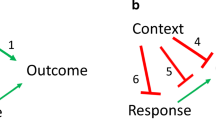Summary
Acute i.p. injection of diazepam (1 mg/kg) resulted in a moderate increase in the tail-flick latency in rats. Tolerance to this diazepam effect developed after 10 days of diazepam treatment (1 mg kg−1 day−1). The benzodiazepine antagonist Ro 15-3505 only partially reversed the effect of diazepam on nociception. Naloxone (5 mg/kg i.p.) failed to affect the effect of diazepam on nociception, while the kappa antagonist MR 2266 fully antagonized the diazepam-induced increase of the tail-flick latency.
Diazepam injected intracerebroventricularly (1, 5, 20 μg/rat) did not alter basal nociceptive threshold, however, diazepam injected intrathecally (20 μg/rat) prolonged the tail-flick latency. Furthermore, intracerebroventricular injection of muscimol partially antagonized the i.p. diazepam-induced increase of the tail-flick latency.
These results suggest that benzodiazepine receptor sites are partially involved in the effect of diazepam on nociception and indicate that an indirect kappa-opioid-receptor-mediated mechanism may be involved. The anatomical site of diazepam action on tail-flick latency seems to be at the spinal level. Descending axons to the spinal cord from brain areas reached by intracerebroventricular injection of muscimol seem to modulate the effect of diazepam effect on nociception.
Similar content being viewed by others
References
Altaffer BF, De Balbian Werster F, Hall S, Long CJ, D'Encarnacao P (1970) A simple and inexpensive cannula technique for chemical stimulation of the brain. Physiol Behav 5:119–121
Berge OG, Garcia-Cabrera I, Hole K (1988) Response latencies in the tail-flick test depend on tail-skin temperature. Neurosci Lett 86:284–288
Boulter N, Serrao JM, Goodchild CS, Gent JP (1989) Chlordiazepoxide causes spinally mediated analgesia in the rat. Br J Pharmacol 98:610P
Chakrabarti S, Poddar MK (1989) Effect of diazepam on electroacupuncture induced changes in regional γ-aminobutyric acid of the rat central nervous system. Neurosci Res 7:24–32
D'Amour EF, Smith DL (1941) A method for determinating loss of pain sensation. J Pharmacol Exp Ther 72:74–79
Duncan DB (1955) Multiple range and multiple F test. Biometrics 11:1–42
Dunnett CW (1964) New tables for multiple comparisons with a control. Biometrics 20:482–491
Goodchild CS, Serrao JM (1987) Intrathecal midazolam in the rat: evidence for spinally-mediated analgesia. Br J Anaesth 59: 1563–1570
Haefely W (1983) Antagonists of benzodiazepines: functional aspects. In: Biggio G, Costa E (eds) Benzodiazepine recognition ligands: biochemistry and pharmacology. Raven Press, New York, pp 73–93
Haefely W, Pieri L, Pole P, Schaffner R (1981) General pharmacology and neuropharmacology of benzodiazepine derivatives. In: Hoffmeister F, Stille G (eds) Handbook of experimental pharmacology, vol 55/II, Springer, Berlin Heidelberg New York, pp 12–262
Jurna I (1984) Depression of the nociceptive sensory activity in the rat spinal cord due to the intrathecal administration of drugs: effect of diazepam. Neurosurgery 15:917–920
Kubota K, Sun FY, Sugaya K, Sunagane N (1986) Reversal of antinociceptive effect of caerulin by benzodiazepine. J Pharmacobio Dyn 9:428–431
Mantegazza P, Parenti M, Tammiso R, Vita P, Zambotti F, Zonta N (1982) Modification of the antinociceptive effect of morphine by centrally administered diazepam and midazolam. Br J Pharmacol 75: 569–572
Minfeng R, Jisheng H (1979) Rat tail-flick acupuncture analgesia model. Chinese med J 92:576–582
Moreau JL, Pieri L (1988) Effects of an intrathecally administered benzodiazepine receptor agonist, antagonist and inverse agonist on morphine-induced inhibition of a spinal nociceptive reflex. Br J Pharmacol 93:964–968
Morgan MM, Depaulis A, Liebeskind JC (1987) Diazepam dissociates the analgesic and aversive effects of periaqueductal gray stimulation in the rat. Brain Res 423:395–398
Niv D, Davidovich S, Geller E, Urca G (1988) Analgesic and hyperalgesic effects in midazolam: dependence on route of administration. Anesth Analg 67:1169–1173
Olsen RW (1981) GABA-Benzodiazepine-barbiturate interaction. J Neurochem 37:1–13
Panerai AE, Martini A, Sacerdote P, Mantegazza P (1984) μ-receptor antagonists reverse “non-opioid” stress induced analgesia. Brain Res 304:153–156
Paterson SJ, Robson LE, Kosterlitz HW (1983) Classification of opioid receptors. Br Med Bull 39:31–36
Pizziketti RJ, Pressman NS, Geller EB, Cowan Adler MW (1985) Rat cold water tail-flick: a novel analgesic test that distinguishes opioid agonists from mixed agonists-antagonists. Eur J Pharmacol 119: 23–29
Pomeranz B, Nguyen P (1987) Intrathecal diazepam suppresses nociceptive reflexes and potentiates electroacupuncture effects in pentobarbital-anesthetized rats. Neurosci Lett 77:316–320
Rodgers RJ, Randall JI (1987) Benzodiazepine ligands, nociception and defeat analgesia. Psychopharmacology 91:301–315
Rodgers RJ, Randall JI (1988) Blockade of non-opioid analgesia in intruder mice by selective neuronal and non-neuronal benzodiazepine recognition site ligands. Psychopharmacology 96:45–54
Romer D, Buscher HH, Hill RC, Maurer R, Petcher TJ, Zeugner H, Benson W, Finner E, Milkowski W, Thies PW (1982) Unexpected opioid activity in a known class of drug. Life Sci 31:1217–1220
Walsh TJ, McLamb RL, Tilson HA (1986) A comparison of the effects of Ro (15–1788) and chlordiazepoxide on hot-plate latencies, acustic startle and locomotor activity. Psychopharmacology 88:514–519
Whitwam JG, Niv D, Loh L, Chakrabarti MK (1983) Effect of intrathecal midazolam on nociceptive sympathetic reflexes. Br J Anaesth 55:235
Yaksh TL, Rudy TA (1976) Chronic catheterization of the spinal subarachnoid space. Physiol Behav 17:1031–1036
Zambotti F, Zonta N, Parenti M, Tammiso R, Vicentini L, Conci F, Mantegazza P (1982) Periaqueductal gray matter involvement in muscimol-induced decrease of morphine antinociception. Naunyn-Schmiedeberg's Arch Pharmacol 318:368–369
Zambotti F, Zonta N, Tammiso R, Ferrario P, Hafner B, Mantegazza P (1986) Reversal of the effect of centrally-administered diazepam on morphine antinociception by specific (Ro 15–1788 and Ro 15–3505) and non-specific (bicuculline and caffeine) benzodiazepine antagonists. Naunyn-Schmiedeberg's Arch Pharmacol 333:43–46
Zambotti F, Zonta N, Tammiso R, Conci F, Hafner B, Ferrario P, Zecca L, Mantegazza P (1987) Zopiclone potentiates the antinociceptive effect of morphine in rats. NaunynSchmiedeberg's Arch Pharmacol 336:526–529
Zonta N, Zambotti F, Vicentini L, Tammiso R, Mantegazza P (1981) Effects of some GABA-mimetic drugs on the antinociceptive activity of morphine and β-endorphin in rats. NaunynSchmiedeberg's Arch Pharmacol 316:231–234
Author information
Authors and Affiliations
Additional information
This work was supported by MPI grant
Send offprint requests to N. Zonta at the above address
Rights and permissions
About this article
Cite this article
Zambotti, F., Zonta, N., Tammiso, R. et al. Effects of diazepam on nociception in rats. Naunyn-Schmiedeberg's Arch Pharmacol 344, 84–89 (1991). https://doi.org/10.1007/BF00167386
Received:
Accepted:
Issue Date:
DOI: https://doi.org/10.1007/BF00167386




